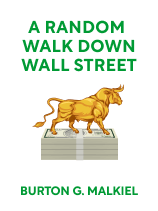

This article is an excerpt from the Shortform book guide to "A Random Walk Down Wall Street" by Burton G. Malkiel. Shortform has the world's best summaries and analyses of books you should be reading.
Like this article? Sign up for a free trial here .
Do you want to know how to find the rate of return on investments? What effective formula can help you predict the rate of return efficiently?
Market projections in the short run—a month, or even a year, from the present—are generally a fool’s errand, but, by knowing which variables to examine, it is possible to make relatively accurate projections of long-term return on investment. Understanding how to find the rate of return will help you to make wiser choices when investing.
Keep reading to find out how to find the rate of return on investments.
How to Find the Rate of Return: A Simple Formula
If you want to know how to find the rate of return, this formula might help. To find the long-term return on investment (at least 50 years) use this simple formula:
Long-run equity return = Initial dividend yield + growth rate.
A stock’s “dividend yield” is the ratio of its dividend to its price; its growth rate is its percent growth in earnings and dividends. In plain language, you can estimate your long-term return on investment of common stock by adding its dividend yield at the time of purchase to the growth rate of earnings and dividends.
(Shortform note: The drawback of this method is that you have to estimate the growth rate of the stock you’re attempting to analyze. Of course, growth rates are impossible to predict with certainty and are vulnerable to unforeseeable (or “Black Swan”) events. Read our summary of The Black Swan.)
For example, say you purchase a share of Thingamajig Inc. for $100. At the time of purchase, Thingamajig pays an annual dividend of $5 a share, which means the dividend yield on the stock is 5%. Then say you estimate an annual growth rate of 5%. Your projected annual return on Thingamajig is thus 10% (or close to it: The formula above doesn’t result in a precise rate of return). Use this advice to find the long-term return on investment.
To calculate returns in the short run, investors must include a third term: the price/earnings multiple. (Analysts will also sometimes use the price/dividend multiple). These ratios of share price to earnings/dividends are highly variable year to year, and so they better reflect the impact of short-run market conditions on returns.
Take Thingamajig again. You’ve bought a share at $100, with a dividend yield of 5% and an estimated annual growth rate of 5%. Let’s say Thingamajig reports earnings of $10 per share. That means its P/E multiple is 10 (because a share of Thingamajig sells for 10x its per-share earnings). Now, imagine a year after you bought Thingamajig, the market enters a recession, and its price plummets to $50. Even if earnings and dividends stay constant, you end up with a lower return at the end of that year—because the P/E multiple has been reduced by half.
As you can see, understanding how to work out the rate of return can give you some idea of how a stock will perform in the short-term and long term.
The Decline of Dividends
Some security analysts argue that dividends are no longer a useful indicator of future returns. This is because more and more companies are electing to distribute profits to shareholders through stock buybacks rather than dividends.
The rationale for preferring buybacks over dividends is twofold:
- Because taxes are generally higher on dividend income than capital gains, companies will buy back stock—which reduces the total number of shares outstanding and increases stock prices—in lieu of distributing dividends.
- Many company executives’ compensation packages include stock options, so executives will prefer to buy back stock—and increase the value of their options—than pay out dividends.
What Comes Next?
In A Random Walk Down Wall Street, economist Burton Malkiel outlines the determinants of returns, and how they’re affected by market conditions, before offering his own predictions for asset returns in the coming years as a part of learning how to find the rate of return on investments. As of late 2018, Malkiel foresaw quite modest long-run annual returns on bonds (about 1%–2%) and slightly higher returns on stocks (around 7%). Malkiel’s predictions for long-run returns in the years to come are based on the determinants as they stood in mid-to-late 2018.
As of mid 2018, dividend yield for the S&P 500 Index was just south of 1.9%. If earnings growth averages 5%—a reasonable supposition given restrained inflation and historical averages—then you’re looking at a long-run return of around 7%.
Note that P/E multiples, which are more important for short-term estimates, weren’t included in this calculation. One way to incorporate this variable into a long-run estimate is a smell test: Do P/E multiples in the present seem high relative to the historical averages? In 2018, the P/E multiple for the S&P 500 was in the high teens—somewhat higher than its historical average of 15.81. Thus one might anticipate a modest correction in the next 10 or so years, especially if interest rates and/or inflation rise.
(Shortform note: As of August 2020, the S&P 500 P/E multiple was 28.33, nearly double its historical average.)
Practice Projecting Returns
Understand how to find the rate of return:
- A share of Widget Corp. sells for $20, pays a $1 dividend annually, and has an estimated growth rate of 5%. What is the estimated annual return on Widget Corp.?
- A zero-coupon bond with a face value of $1,000 sells for $600 on the market. What is the estimated future return on the bond?
- To estimate stocks’ short-term returns, investors must consider a third factor in addition to dividend yield and growth rate. What is that third factor and how does it affect returns?
The above formulas and tips will help you to understand how to find the rate of return for your stocks, but can’t offer any guarantees.

———End of Preview———
Like what you just read? Read the rest of the world's best book summary and analysis of Burton G. Malkiel's "A Random Walk Down Wall Street" at Shortform .
Here's what you'll find in our full A Random Walk Down Wall Street summary :
- A comprehensive and entertaining introduction to the world of finance
- Practical investment principles that work for every skill level
- The advantages of index investing






